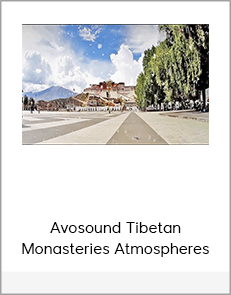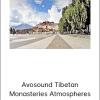Avosound Tibetan Monasteries Atmospheres
$40.00$197.00 (-80%)
As a supplement to the this Library, over 2 hours of audio material from tibet can be found on Tibetan Atmospheres.
Avosound Tibetan Monasteries Atmospheres

Check it out: Avosound Tibetan Monasteries Atmospheres
The ‘Tibetan Monastery Atmospheres’ Sound Archive contains recordings from the everyday monastic environment of Tibetan monks. Apart from atmospheric recordings of the monasteries in Sachung, Rebkong, Langmusi and the religious centre in Labrang, ‘Tibetan Monastery Atmospheres’ also contains the chanting of the monks as well as the rattle of prayer wheels and various other devices.All recordings were made in the Tibetan highlands of the Amdo region, north-east of the capital city of Lhasa – which was cut off entirely from the rest of the world during our stay there. There was no way to get to Lhasa without a Chinese passport (not even for Tibetans).
As a supplement to the this Library, over 2 hours of audio material from tibet can be found on Tibetan Atmospheres.
Sound Recordings from Tibetan Monasteries in Sachung, Labrang, Rebkong, Langmusi
Recordings in 3 Audio Formats: Stereo, Stereo MS, 5.1 Surround Sound
All Recordings in High Definition 24Bit / 96kHz
Little Tibetan Monastery Guide
About Prayer Wheels
About Prayer Flags
Debating Monks – A Buddhist Tradition
Little Tibetan Monastery Guide
A three-week journey through Tibet, a patient guide as well as multiple visits to various monasteries gave us a short but detailed insight into the life of the Tibetans and their cultural and monastic traditions. But considering to the sheer size of the country, our visit offered a mere glimpse into Tibet. Despite many explanations, we have yet to fully grasp the Buddhist belief system. But it is easy to get in contact with Tibetan religion, as it is very tangible and inviting thanks to its various instruments (e.g. prayer wheels, bells, incense sticks).
The geniality of the monks who greeted us on the roof of the world and proudly showed us their monasteries, temples and holy artefacts, will forever stay in our memories. Unlike religious servants in other countries, they were easy-going and unconcerned about etiquette and formalities.
We would like to give you a brief intro to the world of Tibetan monasteries in connection with our sound recordings. However, we are neither scholars nor experts on Tibetan life, so please forgive us any mistakes or omissions (and don’t hesitate to let us know about them either!).
A Tibetan Monastery…
…usually situated in a public place (i.e. a locality formed around the monastery). There is generally a wall around the monastery, usually with a colonnade. Pilgrims and inhabitants do their rounds every day, either clock-wise or counter-clockwise, depending on their religion. Prayer wheels are located in the colonnades or by the monastery walls, so that the pilgrims can turn them as they walk past. Larger versions of prayer wheels are located near the entrances or in corners of the wall, stored in their own little housings. Near any monastery, the constant rattle of prayer wheels can be heard in the cold Tibetan morning air. Similarly noisy are the three-wheel trucks of the Tibetans that zoom past on the roads.
Depending on the size of the monastery, one or more temples are contained within its walls, each with its own buddha. Larger monasteries even sport an assembly square where monks debate and listen to the Lhama’s speeches (the Lhama is the religious leader) – or they are being verbally punished by their teachers for improper behaviour or sloppy dressing. As social status is linked to having one or more members of a family become a monk, many young people in a monastery are not there by their own volition.
Each monastery is different, even in its construction and its layout. Some temples for praying and singing are exposed to the elements which can be quite uncomfortable depending on the time of year. The enclosed temples are more cosy, as they are usually decorated with pillows and fabrics.
The Prayer Wheel
A Prayer Wheel is a drum with printed prayers that can be rotated around a spindle. These so-called prayer wheels can be found in any Tibetan monastery; they are as much part of the inventory as the ubiquitous buddha statues, butter candles or stupas. Prayer wheels are often located in long hallways, hundreds of meters apart, where pilgrims make use of them in passing. Large prayer wheels are several meters in height and require quite some force to spin. The larger ones also sport a small bell that indicates a complete spin of the wheel and hence the completion of a mantra. The spinning of the prayer wheel signifies good karma in the buddhist belief system. We hope to have captured some of that good karma in our recordings as well!
The water operated Prayer Wheel
The more you spin the mantra on the prayer wheel, the better your karma. As a result, monks came up with the idea of building water operated prayer wheels near brooks and rivers.
Future developments include wind operated prayer wheels and even some electrical ones, but we didn’t see either ones on our travels.
Prayer Flags
Like the mantras on prayer wheels, religious texts are printed on small flags so that their meanings are carried into the world by the wind. Prayer flags are mainly placed around holy locations, e.g. rivers, lakes, brooks (inshore waters in general), mountains, passes, gorges, caves etc. Often they are placed where good fortune is required – the wishes are then written onto the fabric, which is supposed to make them come true. In places where there are no trees, the flags are placed on stakes (sometimes they endure over generations, decaying slowly in the wind).
Weird Structures
In general, prayer flags are placed wherever there is a plethora of them already – or near holy places. In short: the windier the place, the better (and there are lots of windy places in Tibet!). This leads to some impressively weird structures, such as the one pictured, which is more than 20 meters high and near a holy lake. Unfortunately, placing another flag in such a spot feels rather superfluous – and it is doubtful if the prayer would even find its way across the world!
Debating
Debating is part of the buddhist doctrine and practiced almost every day on the official debate square inside the monastery. The monks line up in pairs and one of them will ask his sitting counterpart a question that does not necessarily need an answer. With a loud clap of the hands, the question is passed on to the debating partner, who then also tries to give an answer to the question. Or at least that’s how this custom was explained to us…
Debating is a rather noisy affair and it is absolutely fascinating to watch the monks really get into it. It would be even more fascinating if we could actually understand what was being said!
Monastery Atmospheric Sounds
Prayer Wheels
Monks
in High Definition 24Bit / 96 kHz














